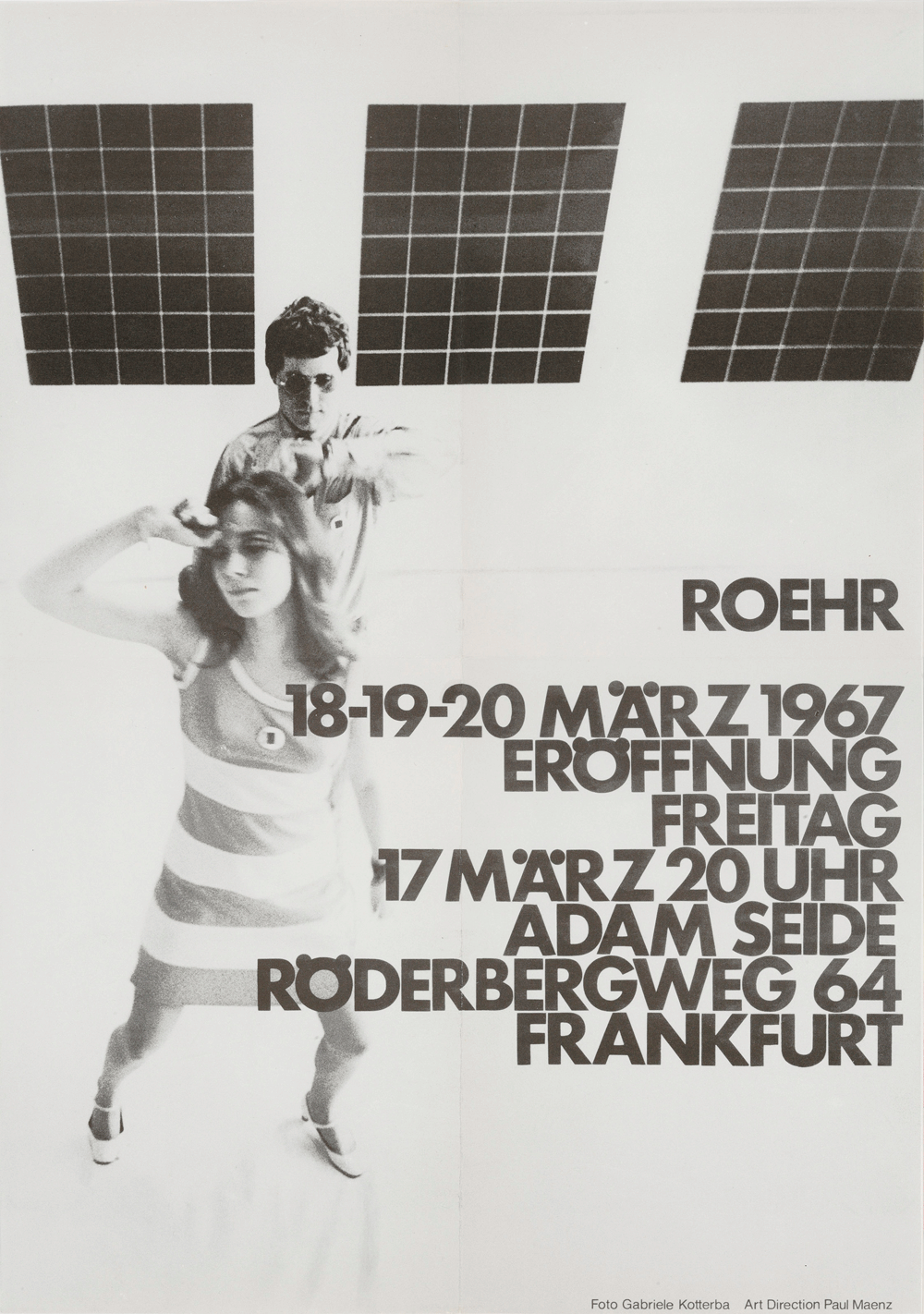Peter Roehr
Stadel Museum and Museum für Moderne Kunst, Frankfurt am Main, Germany
Stadel Museum and Museum für Moderne Kunst, Frankfurt am Main, Germany

‘What goes around comes around.’ This phrase can be aptly applied to both the serial art of Peter Roehr and to the cycles in style that have brought us, 42 years after his premature death, to a period with a taste for minimal conceptualism that makes his practice seem particularly ripe for rediscovery. With two recent and extensive solo shows in Frankfurt’s major museums, it’s stunning that the entire oeuvre of this relatively unknown German artist – amounting to more than 600 pieces – was produced in only five years, between 1962 and 1967. Furthermore, the impressive theoretical leaps and the precise and cohesive thinking evident in his works were those of an artist who died at the age of 23.
Although the two exhibitions were broken up so that the viewer had to reconnect the chronological dots, each was a satisfying retrospective in its own right. Both revealed the overriding principle of Roehr’s art: an exploration of serial repetition. It is not surprising to learn that, when he first started to go down this path as an 18 year old, Roehr was studying Zen Buddhism, which incorporates the belief that things have no beginning and no end, as well as the use of repetitive chanting to reach a state of higher consciousness. In a short space of time, experimenting with a variety of media – sound, film, typography, photos and ready-made objects – his working methods became ever-more exacting and radical.
The MMK show included some early canvases and works on paper from 1962–3, which revealed Roehr casting around for his own style, dipping into Arte Povera and Dada. But this section of the survey more fully explored the untitled works from his ‘advertising period’, beginning in 1964, in which Roehr cut out identical colour images from brochures and laid them out up to 36 times in precise grids. It also includes his black and white ‘Film Montages’ (1965), in which commercials were spliced into clips so that a single action repeated several times for up to two minutes: cars driving through a tunnel; a woman combing her hair after a passing steam train has mussed it up.
The show at the Städel Museum opened with Roehr’s untitled text works from 1963–4, where he relied on the typewriter as a tool for producing endless replication. In subsequent works, Roehr arranged industrially produced items, such as buttons or coins, on stringent grids. Indeed, the artist strictly defined the number of repetitions and their arrangements, as seen in a surviving sketch from 1964 in which he established four possibilities (6x6, 5x7, 3x8 4x8), ensuring that the end result would always be an almost-perfect square.
While the repetitive advertising montages of 1964–5 – mostly based on Maxwell House coffee and Volkswagen brochures – inevitably provoke comparisons with Andy Warhol’s Campbell’s Soup Cans (1962), Roehr was said to be dismissive of the American artist’s use of silkscreen as ‘painterly’ and his images as ‘too Romantic’. Indeed, his own work, though colourful in this period, was much stricter and more reductive: in many of the montages of automobile images, executed in both large and small scale, the repeated element – whether a detail of a gear stick or a birds-eye view of a black Volkswagen Beetle – is often at first unrecognizable, as the pattern completely overwhelms the eye.
Roehr was still not completely satisfied with these photographic and filmic montages, because he feared that the viewer would still be able to discern some narrative. In 1966, therefore, he moved to strictly object-based work, such as his grid experiments from 1966–7, in which he pasted cardboard letters in white or gold onto a white support, emphasizing less the letter than the pattern created by their shadows: a lattice (letter N), brickwork (letter H) or a grille (letter L). Later, he applied large silver balls or Styrofoam packaging to canvases, and labels, stickers and – in one case – beer mats to smaller ones.
Roehr’s magnum opus, Schwarze Tafeln (Black Tablets, 1966), first exhibited at the Galerie Adam Seide in 1967, and recently acquired by the Städel Museum, is a series of ten identical 119-centimetre-square pieces, composed of 35 black cards laid out in a 5:7 ratio. While Ad Reinhardt and Frank Stella had also recently created their own entirely black canvases to address the ‘end of painting’ – and which indeed they branded their ‘final paintings’ – these had still been applied with a brush. Roehr pushed the concept even further, trying to completely remove the hand of the artist. Ironically, in their monumentality and sombre tone, the panels are highly emotional: it was in 1966 that Roehr had learned of his terminal illness. By the time of the show, he was already very sick. These would indeed be his ‘final paintings’ and it’s appropriate that in them he successfully merges his goals: seriality, reduction of content, autonomy of the object and its surrounding space. With these, the young German contemporaneously matched the groundbreaking explorations of artists such as Donald Judd, even if it took the world another 40 years to notice.
























